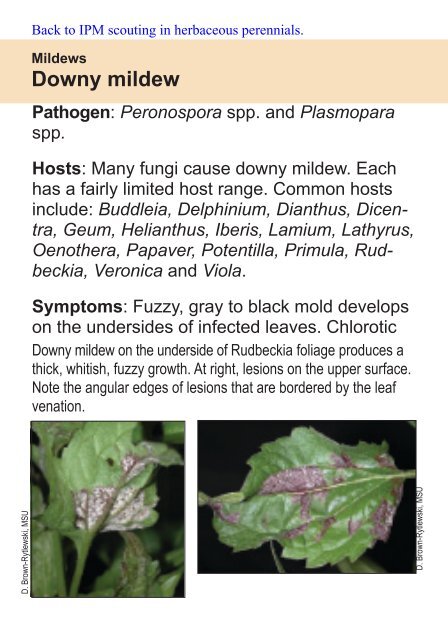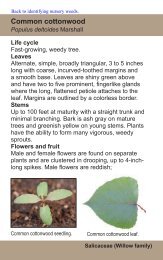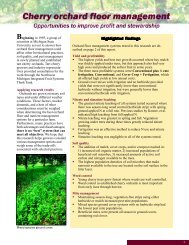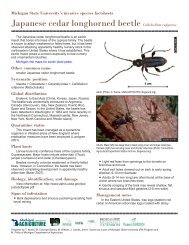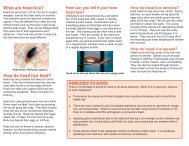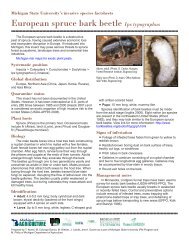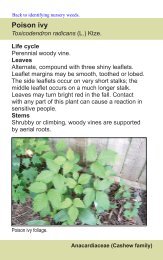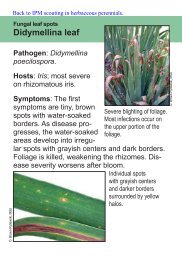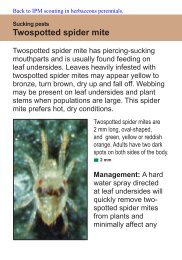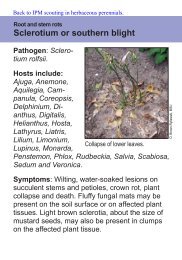Downy mildew
Downy mildew
Downy mildew
You also want an ePaper? Increase the reach of your titles
YUMPU automatically turns print PDFs into web optimized ePapers that Google loves.
Mildews<br />
<strong>Downy</strong> <strong>mildew</strong><br />
Pathogen: Peronospora spp. and Plasmopara<br />
spp.<br />
Hosts: Many fungi cause downy <strong>mildew</strong>. Each<br />
has a fairly limited host range. Common hosts<br />
include: Buddleia, Delphinium, Dianthus, Dicentra,<br />
Geum, Helianthus, Iberis, Lamium, Lathyrus,<br />
Oenothera, Papaver, Potentilla, Primula, Rudbeckia,<br />
Veronica and Viola.<br />
Symptoms: Fuzzy, gray to black mold develops<br />
on the undersides of infected leaves. Chlorotic<br />
<strong>Downy</strong> <strong>mildew</strong> on the underside of Rudbeckia foliage produces a<br />
thick, whitish, fuzzy growth. At right, lesions on the upper surface.<br />
Note the angular edges of lesions that are bordered by the leaf<br />
venation.<br />
D. Brown-Rytlewski, MSU<br />
D. Brown-Rytlewski, MSU
<strong>Downy</strong> <strong>mildew</strong> – continued<br />
or necrotic lesions<br />
appear on the upper surfaces<br />
of infected leaves.<br />
Lesions may have angular<br />
edges; some lesions<br />
are bordered by veins.<br />
Infected foliage may be<br />
cupped, and new growth<br />
may become distorted.<br />
Severely affected plants<br />
Lesion on Potentilla<br />
foliage.<br />
are stunted. Some seedlings can be infected systemically,<br />
causing new growth to be stunted and severely<br />
distorted.<br />
Spread: Spores are readily released and carried by<br />
air currents. Peak spore release often occurs<br />
Mottling symptoms.<br />
Note the angular edges<br />
of the lesions.
<strong>Downy</strong> <strong>mildew</strong> – continued<br />
when relative humidity rapidly decreases, which typically<br />
occurs in the morning. Some downy <strong>mildew</strong>s are<br />
spread by contaminated seed; others are effectively<br />
spread on vegetative cuttings and seedlings.<br />
Management: Scout susceptible incoming plant<br />
material carefully for signs of downy <strong>mildew</strong> paying<br />
careful attention to leaf undersides. Remove and destroy<br />
infected plants. Do not compost the plant debris.<br />
Warm days and cool nights with high humidity are<br />
favorable conditions for downy <strong>mildew</strong> spore production.<br />
Maintain good air circulation and increase night<br />
temperatures in greenhouses. Fungicides should be<br />
used preventively on especially susceptible crops.<br />
<strong>Downy</strong> <strong>mildew</strong>s are capable of developing resistance<br />
to several effective systemic fungicides. Rotate use of<br />
systemic fungicides with protectants to slow resistance<br />
development.<br />
Downward curling and yellowing<br />
of Veronica leaves caused by<br />
downy <strong>mildew</strong>.


